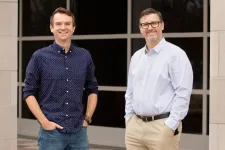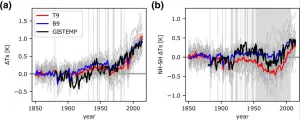Pericardial injection effective, less invasive way to get regenerative therapies to heart
2021-03-03
(Press-News.org) Injecting hydrogels containing stem cell or exosome therapeutics directly into the pericardial cavity could be a less invasive, less costly, and more effective means of treating cardiac injury, according to new research from North Carolina State University and the University of North Carolina at Chapel Hill.
Stem cell therapy holds promise as a way to treat cardiac injury, but delivering the therapy directly to the site of the injury and keeping it in place long enough to be effective are ongoing challenges. Even cardiac patches, which can be positioned directly over the site of the injury, have drawbacks in that they require invasive surgical methods for placement.
"We wanted a less invasive way to get therapeutics to the injury site," says Ke Cheng, Randall B. Terry, Jr. Distinguished Professor in Regenerative Medicine at NC State's Department of Molecular Biomedical Sciences and professor in the NC State/UNC-Chapel Hill Joint Department of Biomedical Engineering. "Using the pericardial cavity as a natural "mold" could allow us to create cardiac patches - at the site of injury - from hydrogels containing therapeutics."
In a proof-of-concept study, Cheng and colleagues from NC State and UNC-Chapel Hill looked at two different types of hydrogels - one naturally derived and one synthetic - and two different stem cell-derived therapeutics in mouse and rat models of heart attack. The therapeutics were delivered via intrapericardial (iPC) injection.
Via fluorescent imaging the researchers were able to see that the hydrogel spread out to form a cardiac patch in the pericardial cavity. They also confirmed that the stem cell or exosome therapeutics can be released into the myocardium, leading to reduced cell death and improved cardiac function compared to animals in the group who received only the hydrogel without therapeutics.
The team then turned to a pig model to test the procedure's safety and feasibility. They delivered the iPC injections using a minimally invasive procedure that required only two small incisions, then monitored the pigs for adverse effects. They found no breathing complications, pericardial inflammation, or changes in blood chemistry up to three days post-procedure.
"Our hope is that this method of drug delivery to the heart will result in less invasive, less costly procedures with higher therapeutic efficacy," Cheng says. "Our early results are promising - the method is safe and generates a higher retention rate of therapeutics than those currently in use. Next we will perform additional preclinical studies in large animals to further test the safety and efficacy of this therapy, before we can start a clinical trial."
"I anticipate in a clinical setting in the future, iPC injection could be performed with pericardial access similar to the LARIAT procedure. In that regard, only one small incision under local anesthesia is needed on the patient's chest wall," says Dr. Joe Rossi, associate professor in the division of cardiology at UNC-Chapel Hill and co-author of the paper.
INFORMATION:
The research appears in Nature Communications and was supported by the National Institutes of Health and the American Heart Association. Dr. Thomas Caranasos, director of adult cardiac surgery at UNC-Chapel Hill, also contributed to the work.
Note to editors: An abstract follows.
"Minimally invasive delivery of therapeutic agents by hydrogel injection into the pericardial cavity for cardiac repair"
DOI: 10.1038/s41467-021-21682-7
Authors: Dashuai Zhu, Zhenhua Li, Ke Cheng, North Carolina State University; Thomas Caranasos, Joseph Rossi, University of North Carolina at Chapel Hill
Published: March 3, 2021 in Nature Communications
Abstract:
Cardiac patch is an effective way to deliver therapeutics to the heart. However, such procedures are normally invasive and difficult to perform. Here, we developed and tested a method to utilize the pericardial cavity as a natural "mold" for in situ cardiac patch formation after intrapericardial (iPC) injection of therapeutics in biocompatible hydrogels. In rodent models of myocardial infarction (MI), we demonstrated that iPC injection is an effective and safe method to deliver hydrogels containing induced pluripotent stem cells-derived cardiac progenitor cells (iPS-CPCs) or mesenchymal stem cells (MSCs)-derived exosomes. After injection, the hydrogels formed cardiac patch-like structure in the pericardial cavity, mitigating immune response and increasing the cardiac retention of the therapeutics. With robust cardiovascular regeneration and stimulation of epicardium-derived repair, the therapies mitigated cardiac remodeling and improved cardiac functions post MI. Furthermore, we demonstrated the feasibility of minimally-invasive iPC injection in a clinically-relevant porcine model as well as in human patients. Collectively, our study establishes iPC injection as a safe and effective method to deliver therapeutics to the heart for cardiac repair.
ELSE PRESS RELEASES FROM THIS DATE:
2021-03-03
CHAMPAIGN, Ill. -- A smartphone app called Harbor, currently under development by researchers at the University of Illinois Urbana-Champaign, teaches young adults how to talk to a peer if they are concerned about that other person's drinking or drug use.
Designed for people ages 18-29, Harbor teaches young adults how they can "act as first responders for their close friends who demonstrate risky substance use behaviors," according to the app's lead developer, social work professor Douglas C. Smith. Smith, the director of the Center for Prevention Research and Development at the U. of I., focuses his ...
2021-03-03
Boulder, Colo., USA: GSA's dynamic online journal, Geosphere,
posts articles online regularly. Topics for articles posted for Geosphere this month include "a tale of five enclaves"; evidence
for mantle and Moho in the Baltimore Mafic Complex (Maryland, USA); and the
after effects of the 1964 Mw 9.2 megathrust rupture, Alaska.
From Ordovician nascent to early Permian mature arc in the southern
Altaids: Insights from the Kalatage inlier in the Eastern Tianshan, NW
China
Qigui Mao; Jingbin Wang; Wenjiao Xiao; Brian F. Windley; Karel Schulmann
...
Abstract:
The Kalatage inlier in the Dananhu-Haerlik arc is one of the most important
arcs in the Eastern Tianshan, southern Altaids ...
2021-03-03
BROOKLYN, New York, Wednesday, March 3, 2021 - Machine-learning (ML) systems are becoming pervasive not only in technologies affecting our day-to-day lives, but also in those observing them, including face expression recognition systems. Companies that make and use such widely deployed services rely on so-called privacy preservation tools that often use generative adversarial networks (GANs), typically produced by a third party to scrub images of individuals' identity. But how good are they?
Researchers at the END ...
2021-03-03
Nature Communications Publishes Paper by Lundquist Institute Investigator Dr. Wei Yan and Colleagues on New Promising Compound for Male Contraceptive Pill
The Lundquist Institute researchers discovered a natural compound that exhibits almost ideal male contraceptive effects in pre-clinical studies
LOS ANGELES (March 3, 2021) -- In a new paper published by Nature Communications, The Lundquist Institute (TLI) Investigator Wei Yan, MD, PhD, and his research colleagues spell out an innovative strategy that has led to the discovery of a natural compound as a safe, effective and reversible male contraceptive agent in pre-clinical animal models. ...
2021-03-03
A recent analysis of the latest generation of climate models -- known as a CMIP6 -- provides a cautionary tale on interpreting climate simulations as scientists develop more sensitive and sophisticated projections of how the Earth will respond to increasing levels of carbon dioxide in the atmosphere.
Researchers at Princeton University and the University of Miami reported that newer models with a high "climate sensitivity" -- meaning they predict much greater global warming from the same levels of atmospheric carbon dioxide as other models -- do not provide a plausible scenario of Earth's future climate.
Those ...
2021-03-03
Inspired by the eyes of mantis shrimp, researchers have developed a new kind of optical sensor that is small enough to fit on a smartphone but is capable of hyperspectral and polarimetric imaging.
"Lots of artificial intelligence (AI) programs can make use of data-rich hyperspectral and polarimetric images, but the equipment necessary for capturing those images is currently somewhat bulky," says Michael Kudenov, co-corresponding author of a paper on the work and an associate professor of electrical and computer engineering at North Carolina State University. "Our work here makes smaller, more user friendly devices possible. And that would allow us to better bring those AI capabilities to bear in fields from astronomy to biomedicine."
In the context of this research, ...
2021-03-03
Researchers have analyzed tracking data for 5,775 birds across 39 species of albatrosses and large petrels -- threatened seabirds whose ranges span many countries and the high seas -- to estimate how responsibility for their protection should be distributed among nations and international organizations. The authors note that albatrosses and large petrels from all breeding countries spend much of their time on the high seas, indicating that effectively managing these waters is of global interest. These estimates are critical to inform ongoing United Nations discussions to design a global treaty for conserving biodiversity in the high seas, beyond national jurisdictions, the authors write. Many species of albatrosses and ...
2021-03-03
CHAPEL HILL, N.C. - First-year college students are reporting symptoms of depression and anxiety significantly more often than they were before the coronavirus pandemic, according to a study by the University of North Carolina at Chapel Hill.
The study, embargoed for release until March 3, 2021, at 2 p.m. EST, in the journal PLOS ONE, is based on surveys of 419 Carolina students, and reflects the challenge of colleges nationwide to support student well-being.
The study is unique among the growing reports of COVID-19's toll on mental health: researchers followed the ...
2021-03-03
The source of potentially hazardous solar particles, released from the Sun at high speed during storms in its outer atmosphere, has been located for the first time by researchers at UCL and George Mason University, Virginia, USA.
These particles are highly charged and, if they reach Earth's atmosphere, can potentially disrupt satellites and electronic infrastructure, as well as pose a radiation risk to astronauts and people in airplanes. In 1859, during what's known as the Carrington Event, a large solar storm caused telegraphic systems across Europe and America to fail. With the modern world ...
2021-03-03
A huge volume of digital data has been harvested, stored and shared in the last few years - from sources such as social media, geolocation systems and aerial images from drones and satellites - giving researchers many new ways to study information and decrypt our world. In Switzerland, the Federal Statistical Office (FSO) has taken an interest in the big data revolution and the possibilities it offers to generate predictive statistics for the benefit of society.
Conventional methods such as censuses and surveys remain the benchmark for generating socio-economic indicators at the municipal, cantonal and national levels. But these methods can now be supplemented with secondary, mostly pre-existing data, from sources such as cell-phone ...
LAST 30 PRESS RELEASES:
[Press-News.org] Pericardial injection effective, less invasive way to get regenerative therapies to heart




